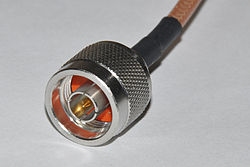- N connector
-
Type N 
Type N connector (male)Type RF coaxial connector Production history Designer Paul Neill Designed 1940s General specifications Diameter Male: 0.800 in (2.03 cm)
Female: 0.550 in (1.40 cm)
(outer, typical)Cable Coaxial Passband 0-11 GHz, often up to 18 GHz  Type N connector Male
Type N connector Male
The N connector (in full, Type N connector) is a threaded RF connector used to join coaxial cables. It was one of the first connectors capable of carrying microwave-frequency signals, and was invented in the 1940s by Paul Neill of Bell Labs, after whom the connector is named.
Contents
Design
Originally, the connector was designed to carry signals of up to 1 GHz in military applications, but the common Type N today handles up to 11 GHz comfortably. More recent precision enhancements to the design by Julius Botka at Hewlett Packard have scaled this to 18 GHz. The male connector is hand-tightened (though versions with a hex nut are also available) and has an air gap between center and outer conductors. The coupling has a 5/8-24 thread. Amphenol [1] suggest tightening to a torque of 15 foot-pounds (20 N·m), while Andrew Corporation suggest 20 for their hex nut variant. Since torque limit depends only on thread quality and cleanliness, whereas the main operational requirement is good RF contact without significant steps or gaps, these values should be seen as indicative rather than critical.
Power rating
The peak power rating of an N connector is determined by voltage breakdown/ionisation of the air near the center pin. The average power rating is determined by overheating of the centre contact and is a function of frequency, as heating depends on the resistive insertion loss. Typical makers curves for a new clean connector with a perfect load such as page 275 of [2] for example imply ~5000 watts at 20 MHz and ~500watts at 2 GHz, i.e. a square root frequency derating law as might be expected from skin depth decreasing with frequency. At lower frequencies the same maker recommends an upper bound of ~1000V RMS. To achieve reliable operation in practice over an extended period, a safety factor of 5 or more is not uncommmon, particularly when generic parts may be substituted, or the operating environment is likely to lead to eventual tarnishing of the contacts.
Impedance options
The N connector follows the MIL-C-39012 standard, defined by the US military, and comes in 50 and 75 ohm versions. The 50 ohm version is widely used in the infrastructure of land mobile, wireless data, paging and cellular systems. The 75 ohm version is primarily used in the infrastructure of cable television systems. Connecting these two different types of connectors to each other can lead to damage due to the difference in diameter of the center pin.[3] Unfortunately, many type N connectors are not labeled, and it can be difficult to prevent this situation in a mixed impedance environment. The situation is further complicated by some makers of 75 ohm sockets designing them with enough spring yield to accept the larger 50ohm pin without irreversible damage, while others clearly do not, and expect users to segragate their connectors and adaptors. In general a 50 ohm socket is not damaged by a 75 ohm pin, but the loose fit means the contact quality is not guaranteed.
The 50 ohm type N connector is favored by enthusiasts who create their own Wireless LAN antenna systems, which run at 2.4 GHz or 5 GHz. The Cantenna is one such design. The enthusiasts have settled on using the N connector as a standard connection for homebrew antennas. By using a cable with an N connector one can easily interchange homebrew antennas. 50Ω N connectors are also commonly used on amateur radio devices (e.g., transceivers) operating in UHF bands.
Variations
SnapN was originally designed by Rosenberger Hochfrequenztechnik in 2006 and is a quick locking replacement for the threaded interface of the widely applied Type N connector. Though part of the Quick Lock Formula Alliance (QLF), engineers at Rosenberger independently designed the SnapN in order to correct the performance issues of QLF’s version of the quick lock N connector, QN. This design achieves better electronic performance because, unlike the QN, this new version maintains the basic structural parameters of the original Type N in which the inner dimensions of the outer conductor are 7.00 mm, and the inner conductor’s outer dimensions are 3.04 mm.
See also
- LC connector
References
- ^ Amphenol, N type datasheet, http://www.amphenolrf.com/products/CatalogPages/TypeN.pdf
- ^ Suhner, Huber. Radio Frequency connector catalogue. pp. 275–276. http://ipaper.ipapercms.dk/hubersuhner/Technologies/Radiofrequency/RFConnectorsEN/.
- ^ Golio, Mike (2008). The RF and Microwave Handbook, Second Edition. CRC. pp. 8–7. ISBN 978-0849372179. http://books.google.com/books?id=MCj9jxSVQKIC&printsec=frontcover&cad=0.
RF connectors (coaxial) APC-7 · BNC · C · F · FME · Hirose U.FL · IPX · Motorola · MCX · MMCX · N · QLS · QMA/QN · RCA · SMA · SMB · SMC · Twin-lead · TNC · TV aerial plug · UHF / Mini-UHF
Variations and alternate names: 2.9 mm (SMA) · 7 mm · Triax / Triaxial · Twin BNC / Twinax (BNC) · IPEX · MHF · AMC (UFL) · SnapN · RP-TNC · RP-SMA
Old or seldom used: EIA · GR · LEMO 00 · MusaSee also: Radio frequency · Radio spectrum · Audio and video connectors · Audio and video interfaces and connectorsCategories:- Coaxial connectors
Wikimedia Foundation. 2010.


